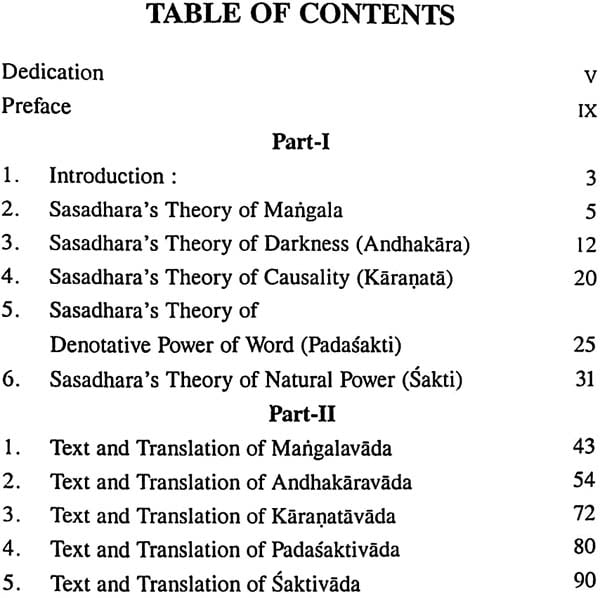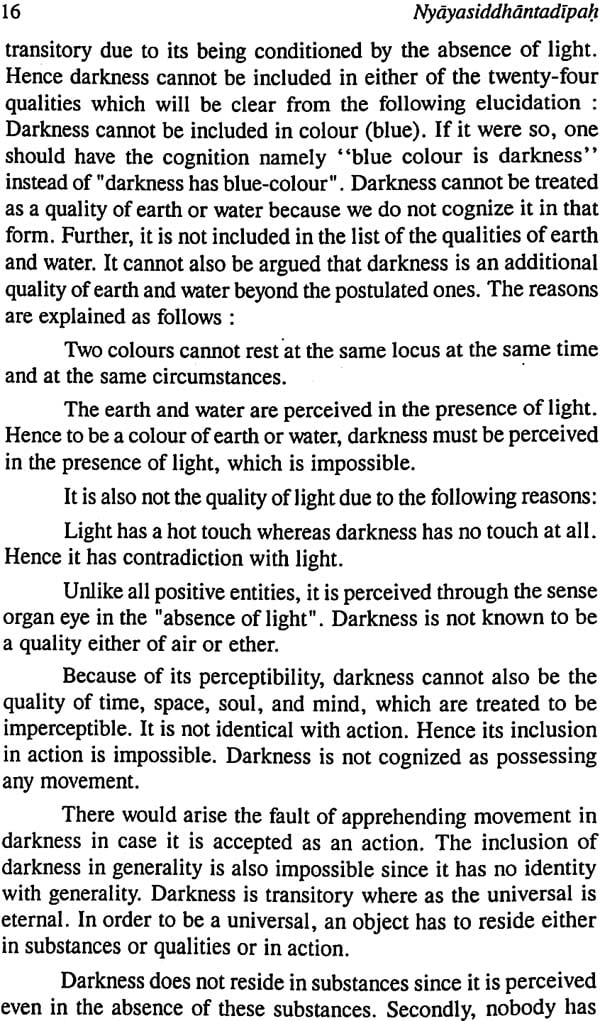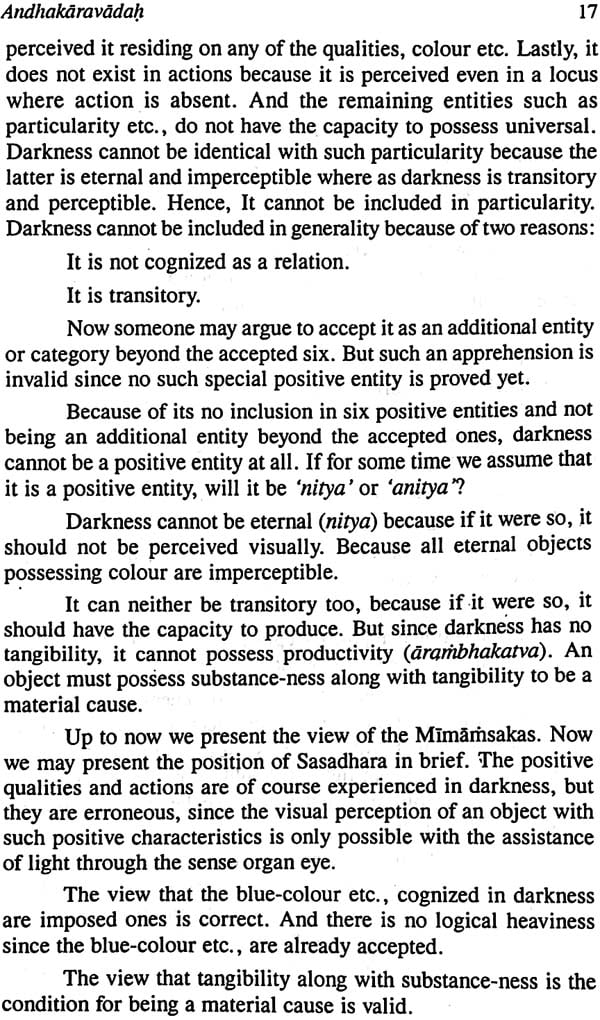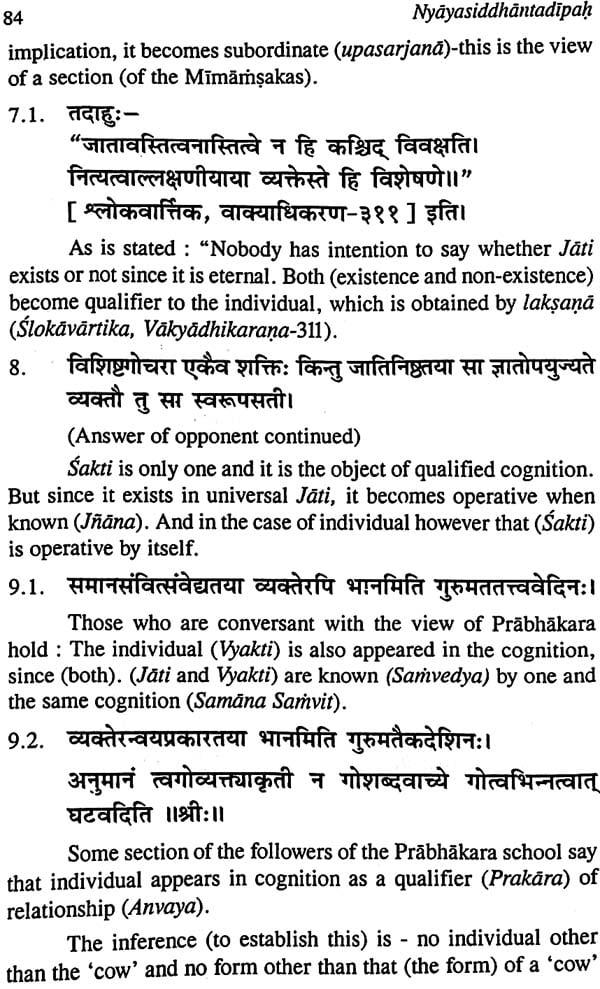
Nyayasiddhantadipah of Sasadhara (Containing the Text English Translation and Critical Study of The First Five Vadas)
Book Specification
| Item Code: | NAP475 |
| Author: | B.K. Dalai |
| Publisher: | Pratibha Prakashan |
| Language: | English |
| Edition: | 2005 |
| ISBN: | 8177012625 |
| Pages: | 107 |
| Cover: | HARDCOVER |
| Other Details | 9.00 X 6.00 inch |
| Weight | 200 gm |
Book Description
Is Indian Philosophy a system of Philosophy? Do Indians etc. are concerned about philosophical problems are some of the questions raised by some Philosophers. They branded Indian Philosophy or rather the literature of Indian Philosophy as religious literature based on faith and are dogmatic by nature having little to do with Philosophy as such. Here in the present work an occasion has been created to make available some sample of Indian Philosophical Literature in English for those who raised these types of objections. The present work is the English translation of Nyayasiddhantadipa with a critical study. Nyayasiddhanta-dipa is a Navya Nyaya text written by Sasadharacharya who held the glorious title of Mahamahopadhyaya (the great Teacher). The most famous and profound exponent of Navya Nyaya school of Philosophy was Gatigega Upadhyaya whose apprdximate time is 1300-1350 AD. agadhara flourished before Gangesa and preceded by almost a century and a half. For the time of Sagadhara, reference may be made to the learned introduction by B.K. Matilal to his critical edition of Nyayasiddhantadipa published by L. D. Institute of Indology, Ahmedabad, in 1976.
Dr. Bata Kishor Dalai is presently working as reader in Centre of Advance Studies in Sanskrit (CASS), University of Poona, Pune
In August, 1988 I joined Sanskrit Department of Pondicherry Central University as a senior lecturer where I had to teach to M. Phil students. My subject was Navya Nyaya and I was supposed to give topics to M. Phil students for their dissertation. I choose the Vadas (Philosdphical discourses) of Nyeiyasiddh- antadipa of Sasadhara, and started giving one one vada to each student. Four of my students worked on four different Vadas to whom the present volume is dedicated. These Vadas were composed on Navya Nyaya styles and based on Philosophical theories. I had to teach the text line by line to them and during this period the idea of bringing out an English translation of the Vadas of Nyayasiddhantadipa came to my mind. The present volume is the out come of that long pending desire.
There are in all twenty six Vadas in Nyciyasiddhantadipa out of which I have translated the first seven Vadas and only five Vadas are incorporated in this volume. They are :
1. Mangalavada, 2. Andhakaravada, 3. Karanatavada, 4. Padasaktivada, 5. Saktivada or Sahajasaktivada. This volume contains English translation of the five Vadas along with a critical analysis of these Vadas as an introduction. This work will help to understand the Navya Nyaya style of writing and also acquaint one with the Philosophical trend of Indian systems.
While preparing this work I have been helped by many scholars and friends to whom I express my gratitude. Prof. N Veezenathan, retired Prof. of Sanskrit, Madras University, had encouraged and shown interest in this work to whom I express my gratefulness. I am indebted to Prof. V.N. Jha, for his kind help and guidance. I express my gratefulness to Prof. S.D. Joshi, former-Director of CASS, for his kind blessings. I also express my gratefulness to Prof. Saroja Bhate, Prof. G.U. Thite of the Department for their cooperation. Prof. M.D. Pandit was always kind towards me and encouraged me to publish this work to whom I express my gratitude.
I thank all my students and friends particularly Dr. Niranjan Jena, Shri Dibakar Mohanty, Modan Mohan Behera, Miss Ranjita Nanda, and Mrs. Smriti Ghosh for their help. I wish them all success in life and career. I thank my son Shri Deepak and daughter Jyotirmayee and wife Dr. Jayanti for allowing me to work and keeping me away from household works.
Lastly I thank Dr. Radhey Shyam Shukla, Pratibha Prakashan, Delhi for publishing this work.
Is Indian Philosophy a system of Philosophy? Do Indians etc. are concerned about philosophical problems?: are some of the questions raised by some Philosophers. They branded Indian Philosophy or rather the literature of Indian Philosophy as religious literature based on faith and are dogmatic by nature having little to do with Philosophy as such. Here in the present work an occasion has been created to make available some sample of Indian Philosophical Literature in English for those who raised these types of objections. The present work is the English translation of Nyaya-siddhantadipa with a critical study. Nvayasiddhantadipa is a Navya Nyaya text written by Sagadharacharya who held the glorious title of Mahamahopadhyaya (the great Teacher). The most famous and profound exponent of Navya Nyaya school of Philosophy was Gangega Upadhydya whose approximate time is 1300-1350 AD. Sagadhara flourished before Gangega and preceded by almost a century and a half. For the time of Sagadhara, reference may be made to the learned introduction by B.K. Matilal to his critical edition of Nyayasiddhantadipa published by L.D. Institute of Indology, Ahmedabad, in 1976. The Nyayasidhantadipa contains 26 Vadas namely, Mangalavada, Andhakaravada, Karantavada, Padasakti- vada, Sahajasaktivada, Mano'nuvada, SSabdapramanyyavada, Jnanakarmasamuccayavada, Muktivada, Sidhartha-pramanyavada, Anavayasaktinisedhavada, Vayupratyaksavada, Nirvikalpakavada, Suvarnataijesavada, Yogarudhi-vada, Lingaparamarsavada, Vyaptivada, Vyaptigrahavada, Vidhivada, Apurvada, Anyatha-Khativada, Arthapattivada, Abhavavada, Sabdanityatavada and Isvaravada. Some portion of Nyayasiddhantadipa was printed in different issues of a now defunct Sanskrit Journal: the Pandit, of Banaras (Vols. XXV-XLII during 1876-1920). Later on Pandit Dhundiraj Shastri in collaboration with M M Vindhesvariprasad Dwivedi, published an edition of, Nyayasidhantadipa along with the commentary, Prabha of Sesananta, published by E.J. Lazarus & Co., Banaras. In 1974 B.K. Matilal brought out an excellent edition of Nyayasiddhantadipa basing on those editions and few more Manuscripts available to him along with the commentary by Gunaratna Sufi. We have made use of this edition of B.K. Matilal. In the present work the first five Vadas are taken for critical analysis. It is arranged in two parts. Part-I presents the contribution of Sasadhara in establishing the doctrine of Nyaya as against the both Mimamsakas the Bhattas as well as Prabhakaras along with the Buddhists on some specific issues like performing Mangala, theory of causality, primary meaning of a word, natural power of objects etc., where different schools have different opinions. Another very important aspect or point to be recorded here is the fact that though Gangesa is treated as the founder of Navya Nyaya, it is Sagadhara who is mostly responsible for the systematization of Navya Nyaya style. Gangesa has greatly been influenced, by Sasadhara’s writing and often has taken from Sagadhara's text for which the comparative table on causality may be referred to. Now a few words on his style of analysis.
The author adopts the traditional method of presenting first the views of opponents who are otherwise known as Purvapaks ins and there after examines, criticizes and finally refutes them on logical grounds through a method technically known as paris kara as prevalent amongst ancient scholars of Indian Philosophical systems. During his discourse, at every step he has to face the Mimarhsakas, Buddhists etc., boldly and this prompted him to strengthen the Nyaya position. Though he is primarily a Naiyayika, takes Siddhanta of Vaisesikas at places to support his theory. In many cases it is observed that he does not blindly follow his predecessors. He applies his own thought and style of argument. On his style Umesha Mishra rightly comments. "His style seems to give growth ty the Navya Nyaya system of examining the problem under discussion". (HIP, Umesha Mishra, p. 224)










